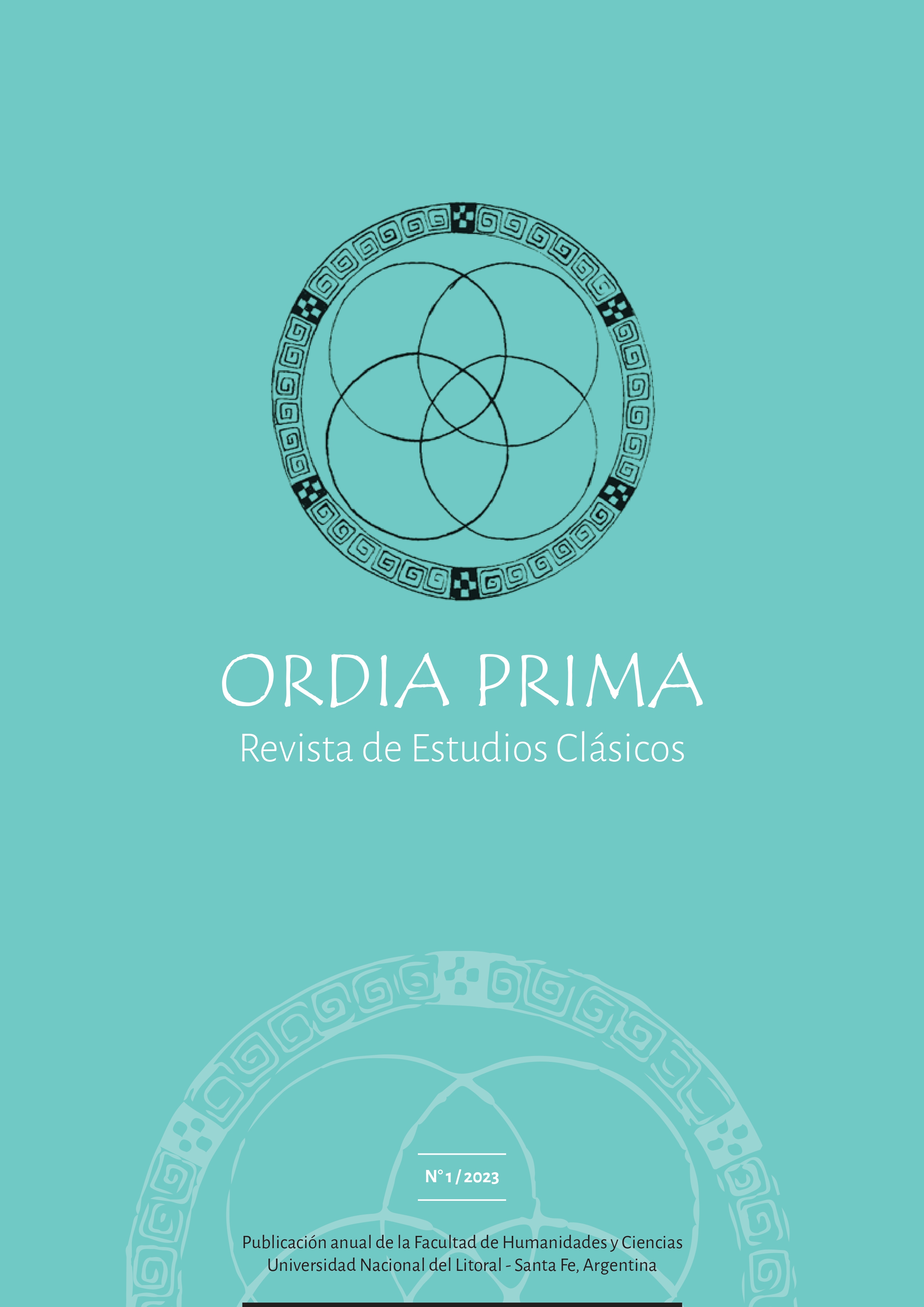Tópicos novelescos y tradición literaria en Herpílide (PDubl. C3)
DOI:
https://doi.org/10.14409/op.2023.1.e0008Palabras clave:
Novela, écfrasis, HerpílideResumen
En esta aportación se propone una interpretación del fragmento novelesco Herpílide (PDubl. C3), señalando los motivos que comparte con las novelas griegas, tanto las conservadas completas como los fragmentos. Se ofrece una traducción del mismo y se realiza un estudio formal del texto, prestando especial atención a su vocabulario, su sintaxis, y las figuras retóricas que utiliza. Se realiza un minucioso análisis de las líneas dedicadas a la écfrasis de la tormenta, desarrollada de acuerdo con las pautas del ejercicio progimnasmático. Se destaca el carácter retórico del texto y el peso de la tradición literaria en él.
Citas
Bartsch, Shadi (1989). Decoding the Ancient Novel. The Reader and the Role of Description in Heliodorus and Achilles Tatius. Princeton University Press.
Bastianini, Guido (2010). PSI XIII 1305. Romanzo di Nino. En Bastianini, Guido e Casanova, Angelo (eds.) I papiri del romanzo antico. Convegno internazionale di studi (pp. 279–288). Florencia.
Brethes, Romain (2017). Clitophon lecteur d’Ovide. En Biraud, Michéle et Briand, Michel (Eds). Roman grec et poésie. Dialogue des genres et nouveaux enjeux du poétique (pp. 133–148). Maison de l’Orient et de la Méditerranée.
Brioso Sánchez, Máximo (2002a). Aspectos del viaje en la novela griega antigua: los medios de transporte. Habis 33, 373–387.
——— (2002b). El viaje en la novela griega antigua. En Brioso, Máximo y Villarrubia, Antonio (eds.). Estudios sobre el viaje en la literatura de la Grecia Antigua (pp. 185–262). Universidad de Sevilla.
Brioso Sánchez, Máximo y Crespo Güemes, Emilio (1982). Longo, Dafnis y Cloe; Aquiles Tacio, Leucipa y Clitofonte; Jámblico, Babiloníacas. Gredos.
Chaniotis, Angelos (2013). Empathy, Emotional Display, Theatricality, and Illusion in Hellenistic Historiography. In Chaniotis, Angelos and Ducrey, Pierre (Eds.). Unveiling Emotions II. Emotions in Greece and Rome: Texts, Images, Material Culture (pp. 53–84). Stuttgart.
Cristóbal, Vicente (2013). Tempestades épicas. Cuadernos de Investigación Filológica, 14, 125–148.
Crönert, Wilhem (1903). Ein neuer griechischer Roman. Archiv für Papyrus–forschung, 2, 365–366.
Crusius, Otto (1897). Die neuesten Papyrusfunde. Beilage zur Allgemeinen Zeitung, 145, 1–2.
Denniston, John Dewar (1959). The Greek Particles (2da. ed.). Oxford University Press.
Diccionario Griego–Español. http://dge.cchs.csic.es/
Díaz Reboso, Samuel (2014). Edición crítica y comentario textual del libro XI de las Metamorfosis de Ovidio (tesis doctoral). Huelva.
Elsner, Jas (2002). Introduction. The Genres of Ekphrasis. En Elsner, Jas (Ed.). The Verbal and the Visual: Cultures of Ekphrasis in Antiquity. Ramus, 31.1–2, págs. 1–18.
Fernández–Garrido, Regla (2019). Relato (διήγημα) y écfrasis (ἔκφρασις) en la novela griega. Myrtia, 34, págs. 105–129.
Gallavotti, Carlo (1931). Frammento di Antonio Diogene? SIFC, 8, págs. 247–257.
Garin, Franceso (1920). Su i romanzi greci. SIFC n.s. 1, págs. 170–171.
Griffin, Alan (1981). The Ceyx Legend in Ovid, Metamorphoses, Book XI, Classical Quarterly 31.1, 147–154.
Hägg, Thomas and Utas, Bo (2003). The Virgin and her Lover. Fragments of an Ancient Greek Novel and a Persian Poem. Brill.
Kanavou, Nikoletta (2018). New Remarks on the Panionis (P.Oxy. Lxxi 4811). Archiv für Papyrusforschung und verwandte Gebiete, 64(1), 13–31.
Kussl, Rolf (1991). Papyrusfragmente griechischer Romane. Ausgewählte Untersuchungen. Gunter Narr Verlag.
Lavagnini, Bruno (1921). Integrazioni e congetture a frammenti di romanzi greci. Aegyptus, 2.2, 200–206.
Liapis, Vayos (2006). Achilles Tatius as a reader of Sophocles. Classical Quarterly, 56.1, 220–238.
López Martínez, María Paz (1998). Fragmentos papiráceos de novela griega. Universidad de Alicante.
——— (2016). Humor y retórica en la novela de Paniónide. Studia Philologica Valentina, 18, n.s. 15, 183–194.
López Martínez, María Paz and Ruiz Montero, Consuelo (2016). Parthenope’s Novel: P. Oxy. 435 revisited. In Montes Cala, José Guillermo; Gallé Cejudo, Rafel; Sánchez Ortiz de Landaluce, Manuel; Silva Sánchez, Tomás (Eds.). Fronteras entre el verso y la prosa en la literatura helenística y helenístico–romana: homenaje al prof. José Guillermo Montes Cala. (pp. 479–489). Levante Editori.
——— (2022). A fragment of a Greek novel? PMil II.17 revisited. In: Capasso, Mario; Davoli, Paola; Pellé, Natascia (Eds.). Proceedings of the 29th International Congress of Papyrology, Lecce, 28th July – 3rd August 2019 (Vol. II, pp. 648–660). Centro di Studi Papirologici dell’Università del Salento.
Mahaffy, John (1897). Papiro greco inédito. Rendiconti della reale academia dei Lincei, ser. 5, vol. 6, 91–96.
Norden, Eduard (1915). Die Antike Kunstprosa vom VI Jahrhundert v.Chr. bis in die Zeit der Renaissance. Erster Band, Berlin.
Parsons, Peter (2018). 5355. Novel (Calligone). The Oxyrrhynchus Papyri LXXXIII, 63–72.
Ramírez de Verger, Antonio y Navarro, Fernando (1995). Ovidio. Metamorfosis. Alianza Editorial.
Reed, Joseph (2013). Ovidio. Metamorphosi, volume V, libri X–XII. (Trad. de G. Chiarini). Milán.
Ruiz Montero, Consuelo (1982). Una interpretación del estilo KAI de Jenofonte de Éfeso. Emerita, 50, 305–323.
——— (1994). Chariton von Aphrodisias: Ein Überblick. Aufstieg und Niedergang der römischen Welt 34.2, 1006–1054.
——— (2017). Personal Names in Antonius Diogenes'Incredible Things Beyond Thule. In Michalopoulos, Andrea; Papaioannou, Sophia and Zissos, Andrew (Eds.) Dicite, Pierides (pp. 107—123). Cambridge University Press.
——— (2020). La novela de Calígone: el texto y su contexto literario. In: Conti, Luz; Fornieles Sáncrez, Raquel; Jiménez López, María Dolores (et al.) (Eds.) Δῶρα τά οἱ δίδομεν φιλέοντες: homenaje al profesor Emilio Crespo (pp. 499–508).
Scarcella, Antonio (1988). Il mare (le fonti, i fiumi): l'altra faccia della geografia ideale dei romanzi erotici greci. Euphrosyne: Revista de filología clássica, 16, 257–270.
Schmeling, Gareth (Eds.) (1996). The Novel in the Ancient World. Brill Academic Pub.
Smyly, J. Gilbart (1901). Fragment of a Greek Romance. Hermathena (11), no. 27, 322–330.
Stephens, Susan and Winkler, John (1995). Ancient Greek Novels. The Fragments, Princeton University Press.
Thesaurus Linguae Graecae. http://stephanus.tlg.uci.edu/index.php.
Webb, Ruth (2009), Ekphrasis, Imagination and Persuasion in Ancient Rhetorical Theoryand Practice. Routledge.
Wilcken, Ulrich (1901). Eine neue Roman–Handschrift. Archiv für Papyrusforschung und verwandte Gebiete, 1(2), 227–272.
Zanker, Graham (1981). Enargeia in the Ancient Criticism of Poetry. Rheinisches Museum 124, 297–311.
Zimmermann, Franz (1936). Griechische Roman–Papyri und verwandte Texte. Heidelberg.
Publicado
Cómo citar
Número
Sección
Licencia
Derechos de autor 2023 Regla Fernández Garrido

Esta obra está bajo una licencia internacional Creative Commons Atribución-NoComercial-CompartirIgual 4.0.



